
Natural gas, is a naturally occurring hydrocarbon gas mixture consisting primarily of methane, but commonly including varying amounts of other higher alkanes, and sometimes a small percentage of carbon dioxide, nitrogen, hydrogen sulfide, or helium. It is formed when layers of decomposing plant and animal matter are exposed to intense heat and pressure under the surface of the Earth over millions of years. The energy that the plants originally obtained from the sun is stored in the form of chemical bonds in the gas. Natural gas is a fossil fuel.

Petroleum is a naturally occurring, yellowish-black liquid found in geological formations beneath the Earth's surface. It is commonly refined into various types of fuels. Components of petroleum are separated using a technique called fractional distillation, i.e. separation of a liquid mixture into fractions differing in boiling point by means of distillation, typically using a fractionating column.
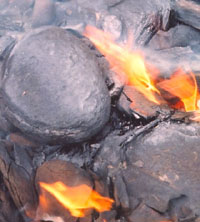
Oil shale is an organic-rich fine-grained sedimentary rock containing kerogen from which liquid hydrocarbons can be produced, called shale oil. Shale oil is a substitute for conventional crude oil; however, extracting shale oil from oil shale is more costly than the production of conventional crude oil both financially and in terms of its environmental impact. Deposits of oil shale occur around the world, including major deposits in the United States. A 2016 estimate of global deposits set the total world resources of oil shale equivalent of 6.05 trillion barrels of oil in place.

A fossil fuel is a fuel formed by natural processes, such as anaerobic decomposition of buried dead organisms, containing organic molecules originating in ancient photosynthesis that release energy in combustion. Such organisms and their resulting fossil fuels typically have an age of millions of years, and sometimes more than 650 million years. Fossil fuels contain high percentages of carbon and include petroleum, coal, and natural gas. Peat is also sometimes considered a fossil fuel. Commonly used derivatives of fossil fuels include kerosene and propane. Fossil fuels range from volatile materials with low carbon-to-hydrogen ratios, to liquids, to nonvolatile materials composed of almost pure carbon, like anthracite coal. Methane can be found in hydrocarbon fields alone, associated with oil, or in the form of methane clathrates.
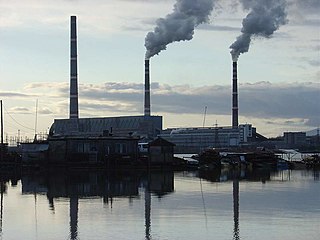
A carbon tax is a tax levied on the carbon content of fuels, generally in the transport and energy sector. Carbon taxes intend to reduce carbon dioxide emissions by increasing the price of fossil fuels and decreasing the demand for them. Carbon taxes are a form of carbon pricing. The term carbon tax is also used to refer to a carbon dioxide equivalent tax, the latter of which is quite similar but can be placed on any type of greenhouse gas or combination of greenhouse gases, emitted by any economic sector.

Biodiesel is a form of diesel fuel derived from plants or animals and consisting of long-chain fatty acid esters. It is typically made by chemically reacting lipids such as animal fat (tallow), soybean oil, or some other vegetable oil with an alcohol, producing a methyl, ethyl or propyl ester.

Alternative fuels, known as non-conventional and advanced fuels, are any materials or substances that can be used as fuels, other than conventional fuels like; fossil fuels, as well as nuclear materials such as uranium and thorium, as well as artificial radioisotope fuels that are made in nuclear reactors.
This list compares various energies in joules (J), organized by order of magnitude.
In energy economics and ecological energetics, energy return on investment (EROI), also sometimes called energy returned on energy invested (ERoEI), is the ratio of the amount of usable energy delivered from a particular energy resource to the amount of exergy used to obtain that energy resource.

Pellet fuels are biofuels made from compressed organic matter or biomass. Pellets can be made from any one of five general categories of biomass: industrial waste and co-products, food waste, agricultural residues, energy crops, and virgin lumber. Wood pellets are the most common type of pellet fuel and are generally made from compacted sawdust and related industrial wastes from the milling of lumber, manufacture of wood products and furniture, and construction. Other industrial waste sources include empty fruit bunches, palm kernel shells, coconut shells, and tree tops and branches discarded during logging operations. So-called "black pellets" are made of biomass, refined to resemble hard coal and were developed to be used in existing coal-fired power plants. Pellets are categorized by their heating value, moisture and ash content, and dimensions. They can be used as fuels for power generation, commercial or residential heating, and cooking. Pellets are extremely dense and can be produced with a low moisture content that allows them to be burned with a very high combustion efficiency.

Hewitt D. Crane (1927–2008) was an American engineer best known for his pioneering work at SRI International on ERMA, for Bank of America, magnetic digital logic, neuristor logic, the development of an eye-movement tracking device, and a pen-input device for computers.
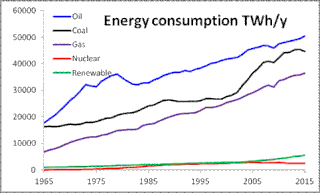
World energy consumption is the total energy produced and used by the entire human civilization. Typically measured per year, it involves all energy harnessed from every energy source applied towards humanity's endeavors across every single industrial and technological sector, across every country. It does not include energy from food, and the extent to which direct biomass burning has been accounted for is poorly documented. Being the power source metric of civilization, world energy consumption has deep implications for humanity's socio-economic-political sphere.
Oil shale reserves refers to oil shale resources that are economically recoverable under current economic conditions and technological abilities. Oil shale deposits range from small presently economically unrecoverable to large potentially recoverable resources. Defining oil shale reserves is difficult, as the chemical composition of different oil shales, as well as their kerogen content and extraction technologies, vary significantly. The economic feasibility of oil shale extraction is highly dependent on the price of conventional oil; if the price of crude oil per barrel is less than the production price per barrel of oil shale, it is uneconomic.
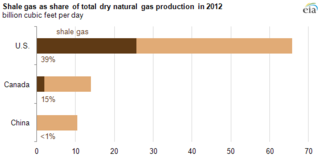
Shale gas is natural gas that is found trapped within shale formations. Shale gas has become an increasingly important source of natural gas in the United States since the start of this century, and interest has spread to potential gas shales in the rest of the world. In 2000 shale gas provided only 1% of U.S. natural gas production; by 2010 it was over 20% and the U.S. government's Energy Information Administration predicts that by 2035, 46% of the United States' natural gas supply will come from shale gas.

Algae fuel, algal biofuel, or algal oil is an alternative to liquid fossil fuels that uses algae as its source of energy-rich oils. Also, algae fuels are an alternative to commonly known biofuel sources, such as corn and sugarcane. When made from seaweed (macroalgae) it can be known as seaweed fuel or seaweed oil.
Vitol is a Dutch energy and commodity trading company that was founded in Rotterdam in 1966 by Henk Viëtor and Jacques Detiger. Though physical trading, logistics and distribution are at the core of the business, these are complemented by refining, shipping, terminals, exploration and production, power generation, and retail businesses. Vitol has 40 offices worldwide and its largest operations are in Geneva, Houston, London, and Singapore. With revenues of $231 billion in 2018, it is the largest independent energy trader in the world, and would rank ninth on the Fortune Global 500 list. Because Vitol does not publish its profits widely, much like most of its competitors in commodity trading, it is largely excluded from rankings. But the company does provide financial information to its lenders and some energy groups with which it trades. The company ships more than 350 million tonnes of crude oil per year and controls 250 supertankers and other vessels to move it around the world. On average it handles more than 7 million barrels a day of oil and products - roughly equivalent to the daily consumption of Japan - the world's third largest oil consumer after the United States and China.
Energy in Gabon comes from two main sources, fossil-fuels and hydroelectricity. Gabon also relies heavily on oil for its export revenues, exporting both crude oil and petroleum. In terms its oil reserves, the country is one of the richest in sub-Sharan Africa, ranking 5th after Nigeria, Angola, Sudan, South Sudan, and Uganda. Renewable energy in the form of solar power is virtually nonexistent.

Energy in Austria describes energy and electricity production, consumption and import in Austria.
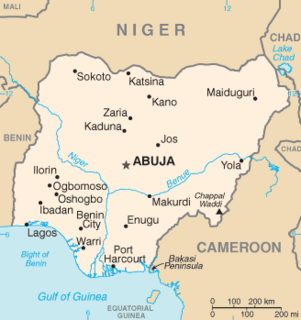
Nigeria's primary energy consumption was about 108 Mtoe in 2011. Most of the energy comes from traditional biomass and waste, which account for 83% of total primary production. The rest is from fossil fuels (16%) and hydropower (1%).

Carbon-neutral fuel is energy fuel or energy systems which have no net greenhouse gas emissions or carbon footprint. One class is synthetic fuel produced from renewable, sustainable or nuclear energy used to hydrogenate carbon dioxide directly captured from the air (DAC), recycled from power plant flue exhaust gas or derived from carbonic acid in seawater. Renewable energy sources include wind turbines, solar panels, and hydroelectric powerful power stations. Another type of renewable energy source is biofuel. Such fuels are potentially carbon-neutral because they do not result in a net increase in atmospheric greenhouse gases.














